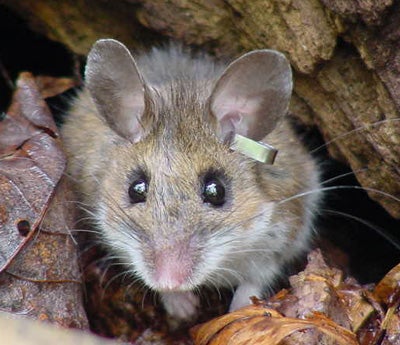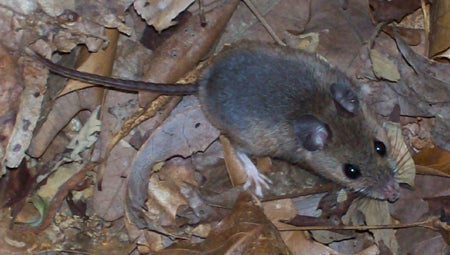SCIENTIFIC NAME:
Peromyscus Leucopus
OTHER NAMES:
Wood Mouse
STATUS:
Poorly known. Occurs in northern two-thirds of state. Lowest Conservation Concern.
DESCRIPTION:
White-footed deermice are six to eight inches in length with tails between 2.5 to 3.8 inches and generally weigh less than one ounce. Adult deermice have fur that varies from rich reddish-brown to dark brown above with underparts being white. Juvenile deermice are slate gray above. Similarities exist between several Peromyscus species. However, generally the cloudland deermouse has a tail that is more than half the total length of its body, while the white-footed deermouse has a tail that is almost always less than half its total length. Also, another similar species, the cotton deermouse, is usually darker in coloration and has a larger hind foot.
DISTRIBUTION:
Peromyscus leucopus is found throughout the United States except the states of Washington, Idaho, Oregon, Nevada, Utah, California and Florida. It can also be found to the north, from Saskatchewan eastward into Nova Scotia and to the south in eastern Mexico,southern Mexico and the Yucatan Peninsula.
HABITAT:
White-footed deermice are found in urban areas with adequate cover such as city parks and stream banks that are not overly manicured. In woodland areas these mice are commonly found in brushpiles, under fallen logs and among boulders. They may also be found along brushy fencerows, on cliffs, in caves, and in man-made structures, such as cabins.
FEEDING HABITS:
White-footed deermice feed onbasswood seeds, wild cherries, beechnuts, acorns, hickory nuts, and seeds of many wild shrubs, weeds, clovers and grasses. Seeds may be stored in burrows or cavities of old stumps. Those living near cultivated fields may rely heavily on grain. Insects and other invertebrates supplement the diet.
LIFE HISTORY AND ECOLOGY:
White-footed deermice are nocturnal and active year round. They live primarily on the ground but are to an extent arboreal. These deermice do not make runways but will use burrows of chipmunks and other animals. Nest sites are commonly found above ground in hollow trees, woodpecker holes, birdhouses, or leaf nests of squirrels. Ground nesting areas include stone or trash piles, caves, rock crevices and buildings. Nests are globular structures six to 10 inches in diameter and are composed of soft materials including grass, leaves, paper, feathers and cloth. White-footed deermice undergo one complete molt per year, usually in the fall, and may also undergo a partial molt. The first litter of the year is usually born in April after a 23 to 25 day gestation period. Three more litters of one to seven young may be born before November. Young are born blind and hairless and weigh about 1/10 of an ounce. Eyes open within 12 to 14 days and young are weaned in 24 to 28 days. Females are able to breed at 10 weeks of age, and may be pregnant and lactating simultaneously. White-footed deermice are prey items for owls, foxes, weasels, cats, and snakes.
REFERENCES:
Barbour, Roger H., and Davis, Wayne, H., 1974. Mammals of Kentucky. The University Press of Kentucky. 322 pp.
Osgood, Wilfred H. 1909. Revision of the Mice of the American Genus Peromyscus. North American Fauna. No. 28. 285 pp.
Aguilar, Shaina. Animal Diversity Web, University of Michigan Museum of Zoology.
AUTHOR:
Bruce Todd, Wildlife Biologist, Alabama Division of Wildlife and Freshwater Fisheries







